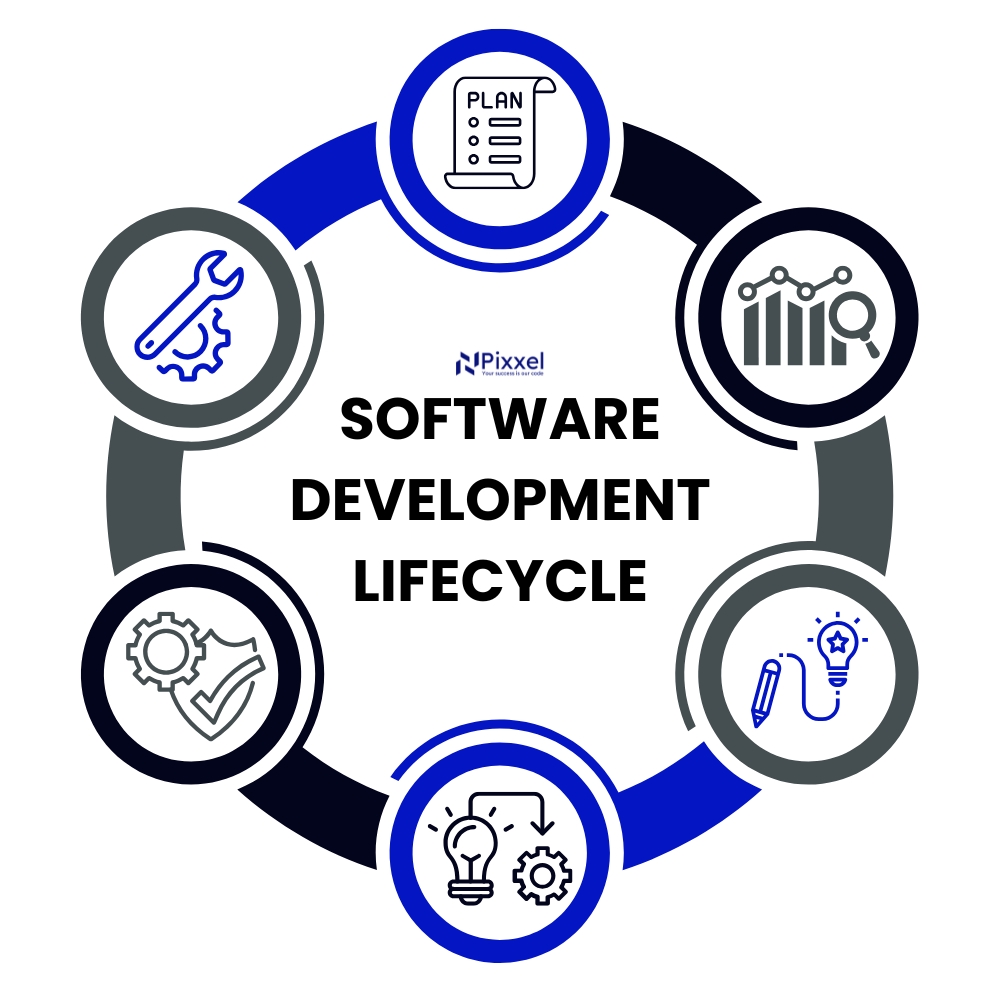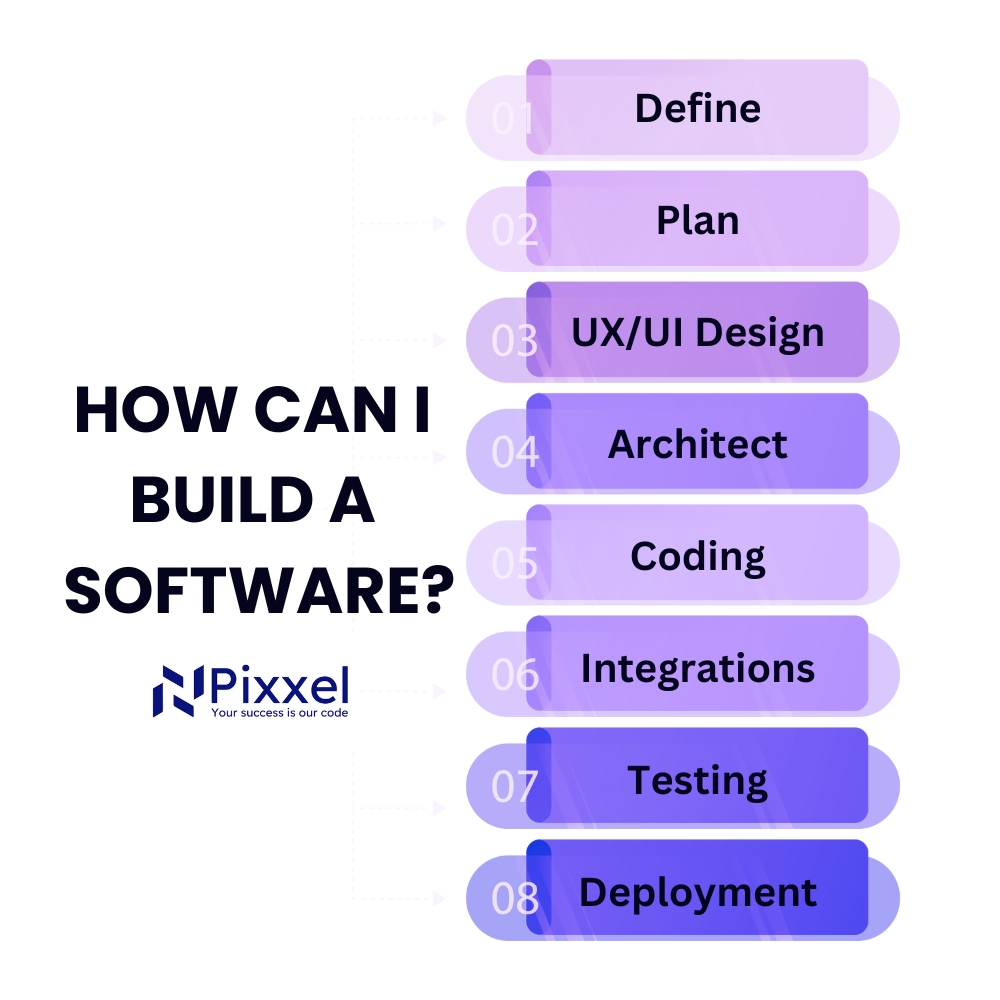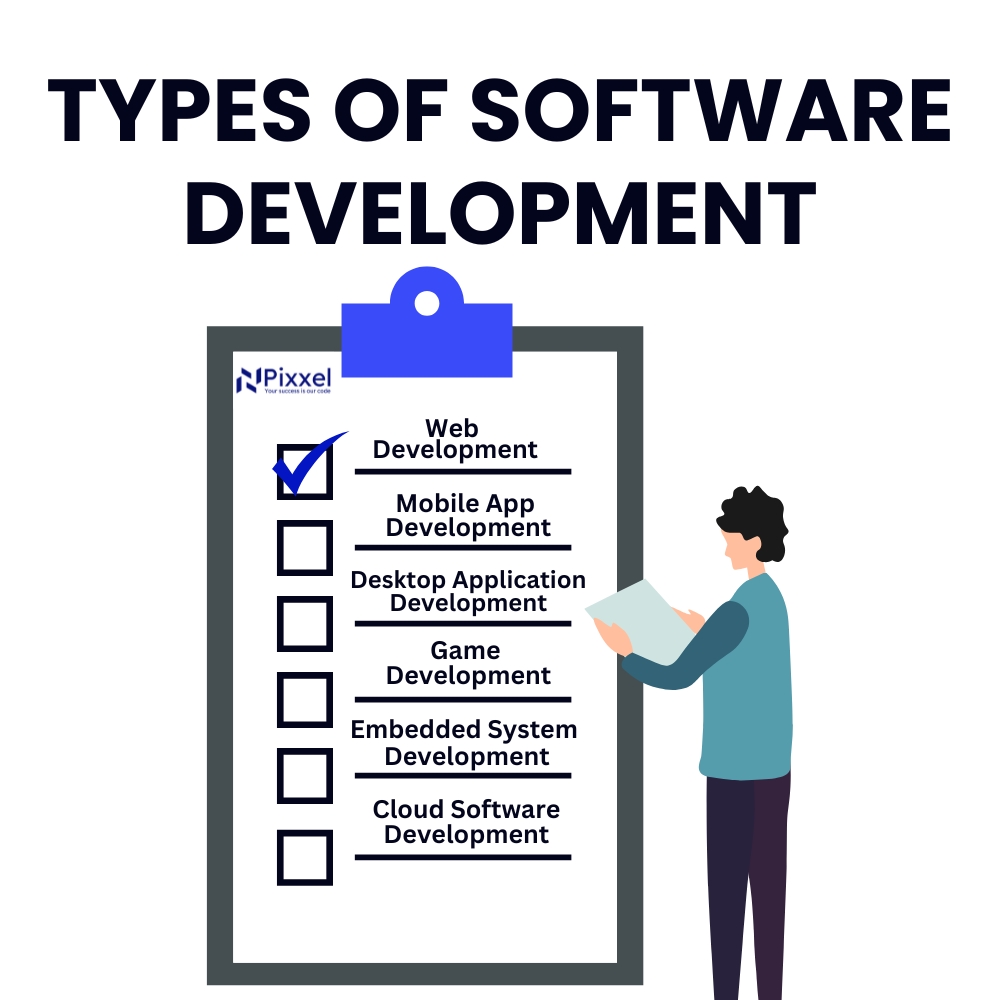Great software doesn’t just happen—it’s built with intention and precision. Every successful software project follows a plan, a structure that guides teams from the first idea to a finished product. That structure is the Software Development Life Cycle (SDLC).
Here’s a striking fact: more than half of software projects face delays or budget overruns because of poor planning and communication. But with the SDLC, you can avoid these pitfalls. It provides a step-by-step framework that ensures your team stays aligned, your project stays on track, and your software delivers exactly what it’s meant to.
In this guide, we will go beyond the basics. We’ll explore how SDLC works, the phases involved, and how to choose the right model for your project. Whether you’re managing a complex enterprise system or launching a small app, these insights will help you make smarter decisions and achieve better results.
Let’s get started. Your path to building better software begins here.
Key Takeaways
- The SDLC provides a structured way to plan, develop, and maintain software.
- Each phase has a clear purpose, from planning to maintenance.
- Choosing the right SDLC model depends on project requirements and complexity.
- Modern tools and practices enhance SDLC, making it adaptable to today’s needs.
- Continuous improvement ensures the SDLC remains effective for future projects.
What is SDLC?
The SDLC is a roadmap for building software in a systematic way. Using a software development life cycle, we provides a
structured sequence of stages to follow, ensuring the development process is organized and efficient.
Overview of Software Development Life Cycle
The SDLC is a framework that defines how we conceptualize, build, and maintain the software. We divide it into distinct phases, each focusing on a specific part of the development process. This structured approach ensures that all aspects of the project are addressed, reducing the risk of errors and inefficiencies. Think of it as a step-by-step guide that helps teams turn ideas into functional, reliable software.
Objectives of SDLC
Our primary objective of SDLC is to create software that meets our user requirements while being efficient, cost-effective, and easy to maintain.
We ensure that the development team has a clear understanding of what they need to build, why they are building it, and how they will achieve it. The SDLC also aims to reduce risks, minimize errors, and provide a predictable timeline for project completion.
Benefits of using SDLC
The SDLC offers numerous benefits for software development projects.
- It helps teams stay organized by breaking the process into manageable stages.
- It improves communication among stakeholders.
- It ensures that the final product aligns with user expectations.
- It reduces development costs by identifying issues early.
- It guarantees a higher quality product that is both functional and user-friendly.
Why is SDLC Important?
The SDLC plays a crucial role in ensuring that software development projects are successful, efficient, and aligned with business goals.
Ensuring efficiency and quality
Our software development life cycle provides a structured process that eliminates guesswork. By following predefined steps, teams can focus on delivering high-quality software without unnecessary delays or confusion.
Each phase includes checks and reviews, ensuring that the product meets quality standards before moving to the next stage.
Reducing costs and risks
We ensure that our SDLC is well-planned and identifies potential risks and challenges early in the process. This allows teams to address issues before they escalate, saving time and money.
For example, identifying a design flaw during the planning phase is far less costly than fixing it during development.
Supporting collaboration and alignment
We ensure that our SDLC promotes clear communication and collaboration among team members and stakeholders.
We also ensure that everyone involved in the project knows their role, understands the goals, and works toward a common objective. This alignment reduces misunderstandings and ensures the project stays on track.
The Six Phases of the Software Development Life Cycle
The SDLC is divided into six key phases, each contributing to the project’s overall success. Let’s dive into each of them and learn them in detail.
Phase 1: Planning
The planning phase is the foundation of the SDLC. In this phase, we identify the project’s goals, the software development costs, understand the target audience, and outline the software’s scope.
During this phase, our teams perform market research, competitor analysis, and feasibility studies. The result is a roadmap that defines the project’s objectives, software development timelines and required resources.
Phase 2: Requirements Analysis
In this phase, our teams gather and document the functional and technical requirements of the software. We consult with stakeholders, end-users, and industry experts to understand their needs and expectations.
The outcome is a comprehensive list of requirements that serves as a blueprint for the design and development phases.
Phase 3: Design
In the design phase, we translate the requirements into a visual and technical blueprint. We create user interface designs, choose the software architecture, and decide on the tools and technologies to be used.
The design document created in this phase guides our developers and ensures consistency throughout the project.
Phase 4: Implementation
Implementation is where the actual coding happens. Our developers write the code based on the design specifications and requirements.
We also integrate different components of the software to ensure they work together seamlessly. Our developers often follow coding standards and use version control systems to manage the codebase effectively.
Phase 5: Quality Assurance and Testing
Testing ensures that the software is functional, reliable, and free from bugs. In this phase, we perform unit testing, integration testing, and system testing to validate that the software meets the requirements.
Any issues discovered during this phase are resolved by our team before the software is deployed.
Phase 6: Support and Maintenance
Once the software is live, it enters the support and maintenance phase. In this phase, we monitor its performance, fix any issues that arise, and update the software to meet changing user needs. Maintenance ensures that the software remains relevant and effective over time.
How SDLC Phases Work Together
Each phase of the SDLC is interconnected, creating a cohesive process that ensures the successful delivery of software.
Interdependencies between phases
The output of one phase becomes the input for the next. For example, the requirements gathered in phase two guide our design phase, and the design serves as the foundation for our implementation. This interdependence ensures that the project progresses logically and efficiently.
Iterative and sequential approaches
In some projects, we follow a linear, sequential approach, completing each phase before moving to the next.
In others, we use an iterative approach, revisiting earlier phases as new insights are gained. Both methods ensure that the final product meets our user needs and expectations.
Role of feedback and continuous improvement
Feedback is essential at every stage of the SDLC. It allows our teams to identify and address issues early, improving the quality of the software. Continuous improvement ensures that the product evolves to meet changing user needs and market conditions.
SDLC Models
Different projects have unique requirements, and that’s why there isn’t a one-size-fits-all approach to software development.
Various Software Development Life Cycle (SDLC) models exist to provide structure, each suited for specific scenarios and project needs.
The choice of the right model can significantly impact the efficiency and success of your project. Here’s an in-depth look at the most popular SDLC models.
Waterfall Model
The Waterfall Model is one of the oldest and most straightforward SDLC approaches. In this model, we follow a strictly
linear progression where each phase is completed before moving on to the next. This sequential structure makes it highly methodical, ensuring clarity and focus at every stage.
- When to use it: This model is best suited for projects with well-defined requirements that are unlikely to change during development. Examples include government or regulatory projects where detailed documentation is critical.
- Advantages: Its clear structure makes planning and tracking for us easy. Each phase has defined deliverables, which provide a sense of completion.
- Limitations: The rigidity of the Waterfall Model can be a drawback if unexpected changes arise. Since testing happens only after the development phase, issues discovered late can be costly to fix.
Agile Model
The Agile Model takes a more flexible and collaborative approach to software development. Instead of treating the SDLC as a single, linear process, we break the project into smaller iterations or sprints. Each sprint delivers a working piece of the software that can be tested and reviewed.
- When to use it: Agile is ideal for projects in which we have evolving requirements or where customer feedback plays a significant role in shaping the final product. Examples include startups and consumer-facing applications where market needs shift rapidly.
- Advantages: Continuous delivery of working software allows for regular feedback and adjustments. It helps us promote collaboration between stakeholders, developers, and users.
- Limitations: Agile requires active and ongoing participation from all stakeholders. Without proper coordination, it can become chaotic, leading to scope creep or delays.
Iterative Model
In the iterative model, we focus on creating small, functional parts of the software and improving them through multiple iterations. Instead of completing the entire software at once, our developers build and refine it piece by piece.
- When to use it: This model works well for projects where requirements are not fully defined at the start but are expected to evolve over time. Examples include research and development projects or new technology implementations.
- Advantages: Early prototypes allow our teams to gather feedback and make adjustments. Each iteration adds value, enabling quicker delivery of functional features.
- Limitations: Frequent iterations can lead to resource overuse if not managed properly. Without clear goals, the process might stretch unnecessarily.
Spiral Model
In the Spiral Model, we combine the iterative approach with risk management. We break the development process into cycles, or “spirals,” where each cycle includes planning, risk analysis, development, and evaluation.
- When to use it: This model is well-suited for large, complex, or high-risk projects that require thorough risk assessment at every stage. Examples include large-scale enterprise software or defense systems.
- Advantages: Risk evaluation in every cycle minimizes uncertainties and ensures better decision-making. The flexibility to revisit phases allows for greater refinement.
- Limitations: It requires expertise in risk analysis and can be more expensive and time-consuming compared to other models.
V-Shaped Model
The V-shaped model, also known as the Verification and Validation Model, is an evolution of the Waterfall Model. Each development phase has a corresponding testing phase, ensuring quality at every step.
- When to use it: This model is ideal for projects where the importance of testing is paramount, such as medical devices, financial systems, or aviation software.
- Advantages: By integrating testing into every phase, the V-shaped model ensures that defects are caught early. Its structured approach makes it easier to track progress.
- Limitations: Like the Waterfall Model, it is not flexible. Changes in requirements can disrupt the process, leading to rework and delays.
Big Bang Model
In the Big Bang Model, we take a minimalist approach to planning and emphasize development. We focus all our resources on coding and building the product, with little to no structured requirements or planning upfront.
- When to use it: This model works best for our small projects with straightforward goals and minimal complexity, such as personal or academic projects.
- Advantages: It requires minimal preparation, making it faster to start. Our developers have complete creative freedom.
- Limitations: The lack of planning makes this model highly risky. It is unsuitable for large or complex projects, as errors can be difficult and expensive to fix.
Choosing the Right SDLC Model
Selecting the right Software Development Life Cycle (SDLC) model can make or break your software development project.
The model you choose should align with the size, complexity, and specific requirements of your project. Let’s dive into the key factors that can guide your decision-making process.
Assessing project complexity and requirements
The complexity of your project is one of the most significant factors when choosing an SDLC model.
- Smaller, straightforward projects: If your project has clear objectives and minimal complexity, simpler models like our Waterfall Model may be your best bet. These models are easy to manage, with clearly defined steps and deliverables that ensure smooth execution. For instance, a basic internal tool for tracking tasks might work well with Waterfall.
- Larger, complex projects: For projects involving intricate requirements or evolving goals, flexibility becomes crucial. Models like Agile or Spiral are better suited to handle the dynamic nature of such projects. A large-scale e-commerce platform with changing customer needs is a good example of where Agile thrives.
Rigid requirements vs. Flexible requirements
The nature of your requirements—whether fixed or flexible—plays a critical role in selecting an SDLC model.
- Rigid requirements: If your project requirements are set in stone from the beginning and are unlikely to change, models like Waterfall or V-shaped are ideal. These models rely on comprehensive upfront planning and documentation, ensuring that all aspects of the project are clearly defined before development begins. Think of projects like government systems or compliance-heavy software where regulations dictate the scope.
- Flexible requirements: On the other hand, if you anticipate changes in requirements or additions during the development process, opt for our Agile, Iterative, or Spiral models. These models are designed to accommodate change and adapt quickly, making them perfect for innovative or experimental software.
One major release vs. Continuous delivery
How and when you plan to release your software is another critical consideration.
- One major release: For projects where the final product is expected to be delivered in one go, such as legacy software updates or internal tools, we recommend the Waterfall or V-shaped model. These models focus on delivering a fully functional product at the end of the development cycle.
- Continuous delivery: If you aim to release smaller, functional versions of your product at regular intervals, Agile or Iterative Models are the way to go. Continuous delivery allows teams to launch working software early and frequently, gather user feedback, and refine the product with each release. Mobile apps or SaaS platforms often benefit from this approach, as it enables rapid iterations and user-driven improvements.
Documentation-heavy vs. Communication-focused approaches
Your team’s strengths and working style can also influence the best SDLC model for your project.
- Documentation-heavy: If your team thrives on structure and relies heavily on formal documentation, models like Waterfall and V-shaped are a good match. In these models, we emphasize on creating detailed plans, design documents, and reports, ensuring that every aspect of the project is documented for future reference.
- Communication-focused: If you are looking for collaboration and prefer direct communication, you may find Agile or Scrum more effective. These model allows us to prioritize face-to-face discussions, regular check-ins, and real-time feedback over lengthy documentation. This approach is ideal for projects where stakeholder involvement is high, and quick decisions are needed.
Common SDLC Tools
Tools are the backbone of a smooth and efficient Software Development Life Cycle (SDLC). They help our teams plan, design, develop, test, deploy, and maintain software effectively.
By choosing the right tools for each phase, you can save time, reduce errors, and ensure a higher-quality product. Here’s a breakdown of tools commonly used in each of our phases of the SDLC.
Tools for Planning and Requirement Gathering
The planning phase sets the foundation for the entire project. Our teams use tools that help them stay organized, assign tasks, and track progress efficiently.
- Jira: A robust project management tool widely used for task tracking and managing workflows. Jira is especially useful for our Agile teams.
- Asana: Offers a more collaborative environment for task tracking and team communication, ensuring that everyone stays on the same page.
These tools make it easy for us to manage requirements, set priorities, and collaborate with stakeholders to refine project goals.
Design and Prototyping Tools
The design phase is where we turn ideas into visual representations and blueprints. Tools in this phase help us create wireframes, prototypes, and design mockups.
- Figma: A cloud-based design tool that allows our teams to collaborate in real time. It’s perfect for creating interactive prototypes and sharing feedback instantly.
- Sketch: Popular among our designers, Sketch is great for creating detailed user interfaces and visual mockups.
- Adobe XD: Offers an all-in-one solution for UI/UX design, allowing our teams to create wireframes, prototypes, and animations seamlessly.
These tools ensure that the software’s design is intuitive, user-friendly, and aligned with project requirements.
Development Tools and Environments
During the development phase, integrated development environments (IDEs) provide our developers with all the necessary features to write, debug, and manage code.
- Visual Studio: A versatile IDE that supports multiple programming languages and offers advanced debugging tools.
- IntelliJ IDEA: Highly favored by our Java developers for its intelligent code completion and robust debugging capabilities.
- Eclipse: A powerful, open-source IDE that supports a wide range of languages and is highly customizable with plugins.
These tools streamline coding, enhance productivity, and ensure that the software’s architecture aligns with its design specifications.
QA and Testing Tools
Testing is critical for us to identify and fix bugs, validate functionality, and ensure the software meets quality standards. Automated testing tools are particularly valuable in this phase.
- Selenium: We widely use this tool for automating web application testing, ensuring browsers perform as expected.
- Postman: Perfect for testing APIs, Postman simplifies the process of sending requests and analyzing responses.
- JUnit: A framework used for unit testing in Java, helping our developers ensure individual components function correctly.
These tools allow teams to run thorough tests efficiently, reducing the likelihood of bugs slipping into production.
Deployment and CI/CD Tools
The deployment phase involves pushing the software to production. Continuous integration and continuous delivery (CI/CD) tools help automate this process and ensure smooth rollouts.
- Jenkins: An open-source CI/CD tool that automates the building, testing, and deployment of software.
- GitLab: Combines source control, CI/CD pipelines, and monitoring features into one platform for seamless deployment.
- Docker: Helps package applications and their dependencies into containers, ensuring consistency across different environments.
These tools minimize deployment errors, save time, and ensure that updates reach our users quickly.
Monitoring and Maintenance Tools
Once the software is live, we monitor it to ensure stable performance and identify any issues in real-time. Maintenance tools help our teams address bugs and optimize performance post-deployment.
- New Relic: Provides real-time performance monitoring, helping our teams track application health and detect bottlenecks.
- Nagios: An open-source tool for monitoring servers, applications, and networks to identify potential issues proactively.
- Splunk: An advanced tool for analyzing logs, visualizing data, and monitoring system performance across environments.
These tools are essential for ensuring the software continues to function smoothly and adapts to user needs over time.





